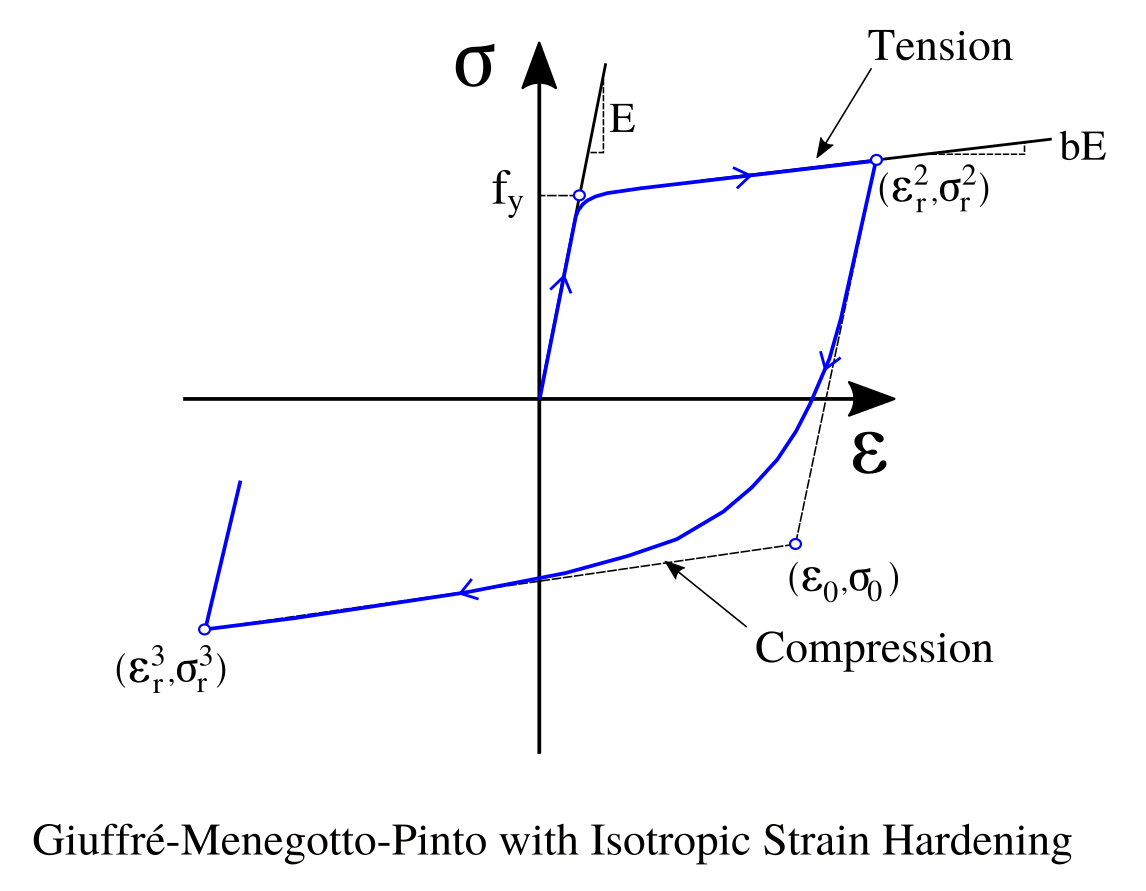The Steel1DFiber class creates a uniaxial material with the constitutive equation given as
\[ \hat{\sigma} = b\,\hat{\epsilon} + \frac{1 - b\,\hat{\epsilon} }{\sqrt[R]{1+|\hat{\epsilon}|^{R}}} \]
where \(\hat{\epsilon}\) and \(\hat{\sigma}\) are defined as
\[ \hat{\sigma} = \frac{\sigma - \sigma_r}{\sigma_0 - \sigma_r}\quad, \quad \hat{\epsilon} = \frac{\epsilon - \epsilon_r}{\epsilon_0 - \epsilon_r} \]
where \(\sigma\) is the uniaxial stress, \(\epsilon\) is the uniaxial strain, and \((\epsilon_r,\sigma_r)\) coordinates of the last strain reversal point in the stress-strain plane and \((\epsilon_0,\sigma_0)\) coordinates of the two asymptotes intersection as illustrated in Figure. The Figure shows the constitutive law of this material.

REFERENCE:
The python Pre-Analysis in the 01-Pre_Process/Method/Attach.py file provides with an interface to populate the Entities dictionary. This file contains several functions to populate specific fields. For example, to create a Steel1DFiber material using json format, use:
addMaterial(tag, name='Steel1DFiber', attributes):
Example
A STEEL1DFIBER can be defined using the python interface as follows:
SVL.addMaterial(tag=1, name='Steel1DFiber', attributes={'fy': 200.0, 'E': 200.0, 'b': 0.1, 'nu': 0.25, 'rho': 0.0})
Application
Please refer to the A18-DY_1D_Material_Fiber_Steel.py file located at 03-Validations/01-Debugging/ to see an example on how to define a PlasticPlaneStrainBA material.
On the contrary, the 01-Pre_Process/Method/Remove.py file provides with an interface to depopulate the Entities dictionary. For example, to remove an already define Material, use:
The C++ Run-Analysis in the 02-Run_Process/02-Materials/03-Fiber/Steel1DFiber.cpp file provides the class implementation. A Steel1DFiber is created using the built-in json parse-structure provided in the Driver.hpp. A Steel1DFiber is defined inside the "Materials" json field indicating its "Tag" as follows,
{
"Materials": {
"Tag": {
"name" : "Steel1DFiber",
"attributes": {
"fy": double,
"E": double,
"b": double
"R0": double,
"cR1": double,
"cR2": double
"a1": double,
"a2": double,
"a3": double,
"a4": double,
"nu": double,
"rho": double
}
}
}
}
| Variable | Description |
|---|---|
Tag | Unique material object identifier. |
fy | Represents the steel yield strength. |
E | Represents the elasticity modulus. |
b | Represents the strain-hardening ratio. |
R0 | Represents the parameters to control the transition from elastic to plastic branches. |
cR1 | Represents the parameters to control the transition from elastic to plastic branches. |
cR2 | Represents the parameters to control the transition from elastic to plastic branches. |
a1 | Represents the isotropic hardening parameter. |
a2 | Represents the isotropic hardening parameter. |
a3 | Represents the isotropic hardening parameter. |
a4 | Represents the isotropic hardening parameter. |
nu | Represents the Poisson's ratio. |
rho | Represents the material density. |
A uniaxial STEEL1DFIBER with elasticity modulus 200, Poisson's ratio 0.25, and no density is defined:
{ "Materials": { "1": { "name" : "STEEL1DFIBER", "attributes": { "fy" : 200.0, "E" : 200.0, "b" : 0.1, "nu" : 0.25, "rho": 0.0 } } } }